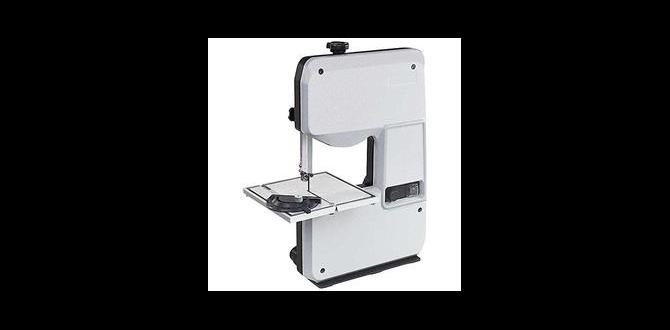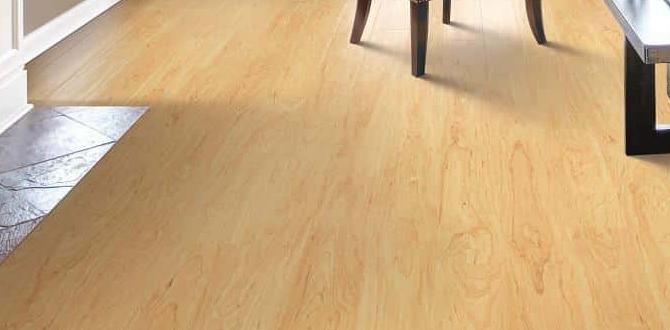Quick Summary:
Mastering long nail strips means understanding their storage, selection, and proper use to avoid jams and ensure projects go smoothly. This guide provides essential tips for picking the right strips, keeping them in top shape, and handling them like a pro, making your woodworking tasks easier and more efficient.
Working on a woodworking project is incredibly rewarding, but sometimes little frustrations can pop up. One common hiccup? Dealing with nail strips that just don’t seem to want to cooperate with your nailer. Whether they’re bending, jamming, or just not feeding correctly, it can bring your project to a halt. Don’t worry; this is a totally normal challenge for DIYers. With a few simple tricks and a bit of know-how, you can avoid these headaches entirely. We’ll guide you through everything you need to know to get those nail strips working perfectly.
This guide is all about making your life easier when it comes to using long nail strips. We’ll cover how to choose the right ones, how to store them so they stay in great condition, and some techniques for troubleshooting if you encounter a problem. By the end of this, you’ll feel much more confident tackling any project that calls for them.
Table of Contents
Understanding Long Nail Strips
So, what exactly are we talking about when we say “long nail strips”? These are essentially collections of nails, typically collated at a specific angle, that are held together by a strip of paper, V-shaped plastic, or sometimes wire. They’re designed to be loaded into a nail gun, allowing you to drive multiple nails quickly and efficiently without having to load them one by one. This is a huge time-saver for any project involving a lot of fastening, from framing a wall to building custom furniture.
The “long” in “long nail strips” just refers to the length of the nails themselves, not necessarily the strip holding them. You’ll find nails in a huge variety of lengths, and the strip will correspond to that length. The collation angle is also super important, as it needs to match what your specific nail gun is designed for.
Why Nail Strip Choice Matters
Choosing the right type and size of nail strip is absolutely crucial for the success of your project and the longevity of your tool. Using the wrong type of nail can lead to:
- Nail Gun Jams: This is the most common problem. If the nails aren’t the right size or collation angle, they won’t feed properly, and your gun will jam, often requiring a frustrating cleanup.
- Damaged Workpiece: Long or thick nails that are too much for your material can split wood, especially softer types.
- Weak Fastening: Using nails that are too short for the job simply won’t create a strong enough joint.
- Tool Damage: Forcing the wrong nails through your nailer can stress internal components, potentially leading to costly repairs.
Think of it like using the right kind of screw for the right job – it makes all the difference. For more on choosing fasteners, check out resources like The Home Depot’s guide on nailer types and uses, which often touches on fastener selection.
Types of Collated Nail Strips
The way nails are held together on a strip is usually referred to as “collation.” This collation method is dictated by the angle and connection material. Understanding these differences is key to selecting the right strip for your nail gun.
1. Paper Collated Nails
Paper collated nails are very common, especially for framing and construction (learn more about framing nailers). The nails are typically glued together at the head with a paper strip. When a nail is fired, most of the paper strip is driven into the wood along with the nail, often disappearing or becoming a minor splinter.
Pros:
- Generally less expensive than plastic collated nails.
- The paper strip often disintegrates, leaving less debris behind.
- Widely available for common construction sizes.
Cons:
- Can be less durable in wet conditions; moisture can weaken the paper strip, leading to separation before use.
- The paper strip can sometimes cause jams if not cleanly severed.
- Nails are typically driven at a specific angle (e.g., 28° or 30°), so you need a gun that matches.
2. Plastic Collated Nails
Plastic collated nails use a V-shaped or straight plastic strip to hold the nails together. These are popular for many applications, including framing, sheathing, and subflooring. The plastic strip is designed to be brittle enough to break apart easily upon impact, usually with the plastic pieces falling away.
Pros:
- More durable and resistant to moisture than paper collated nails.
- Often provide a cleaner break, reducing potential for jams.
- Available in various collation angles (e.g., 21°, 25°, 28°).
Cons:
- Can be more expensive than paper collated nails.
- The plastic pieces can sometimes be larger and more noticeable than paper fragments left behind.
- You must ensure your nail gun is designed to accept the specific collation angle.
3. Wire Collated Nails
These nails are held together by thin wires that are welded or crimped to the nail heads. Wire collated nails are less common for general-purpose nail guns but are often found in coil nailers, which are used for roofing, siding, and some framing applications. When fired, the wire breaks or is cut, and the nails themselves are usually round head, which is suitable for structural work but might not be ideal for finish work where you want a less visible fastener.
Pros:
- Very strong and durable collation.
- Excellent for heavy-duty applications like roofing and siding.
- Coil nailers can hold a large capacity of nails, reducing reloading frequency.
Cons:
- The wire fragments can sometimes get stuck or be harder to remove than paper or plastic.
- Requires specific types of nail guns (coil nailers).
- Not ideal for finish carpentry due to the round head and potential for wire remnants.
Choosing the Right Nail Strip for Your Project
Selecting the perfect nail strip involves a few key considerations: your nail gun, the material you’re working with, and the desired finish. It’s not just about grabbing any strip of nails!
Matching Your Nail Gun
This is the absolute most critical step. Every nail gun is designed to accept nails with a specific collation angle and type. Look for this information on your nail gun itself, in its manual, or on the manufacturer’s website. Common angles include 21°, 25°, 28°, and 30°.
Example: If your framing nailer specifies “28-degree paper collated framing nails,” you must buy that exact type. Using 21-degree plastic collated nails in a 28-degree gun, or vice versa, will almost certainly lead to jams and potential damage.
You can often find this information on a sticker on the gun, usually near the magazine.
Nail Length and Gauge
Nail length should be appropriate for the thickness of the materials you are joining. For example, if you’re attaching 1-inch thick trim to a 2-inch stud, you’ll want a nail that penetrates the stud adequately but doesn’t go all the way through the other side of the wood you’re attaching, if that’s undesirable. A general rule of thumb is to use a nail that is about 2 to 2.5 times the thickness of the piece you are fastening.
The “gauge” refers to the thickness of the nail shank. Lower gauge numbers mean thicker nails, and higher gauge numbers mean thinner nails. Thicker nails (lower gauge) are used for structural applications like framing, while thinner nails (higher gauge) are used for finish carpentry where you want a less visible fastener and to minimize wood splitting.
Here’s a quick look at common gauges and their uses:
| Gauge | Diameter (Approx.) | Common Use | Nailer Type |
|---|---|---|---|
| 15 Gauge | 0.072 inches | Finish nailing, trim, molding, door/window casings | Finish Nailer |
| 16 Gauge | 0.062 inches | Wainscoting, baseboards, crown molding, light trim | Finish Nailer |
| 18 Gauge | 0.047 inches | Very delicate trim, small projects, crafts, paneling | Brad Nailer |
| 8 Gauge (approx. 0.12 in) to 6 Gauge (approx. 0.162 in) | Varies | Framing, subflooring, sheathing, structural connections | Framing Nailer |
Material and Finish
The type of wood you’re working with can also influence your choice:
- Hardwoods (Oak, Maple): You might need thinner nails (higher gauge) to prevent splitting, or you may need longer nails for sufficient holding power.
- Softwoods (Pine, Fir): These are more forgiving, but be mindful of splitting with very thick nails if not careful.
- Exterior Projects: Always use galvanized or stainless steel nails to prevent rust and corrosion, which can stain the wood and weaken the fastener.
- Interior/Finish Work: 15, 16, or 18-gauge nails are common. You might choose finer nails with minimal heads (like brads) for a less visible fastening point, or nails that are designed to be easily set below the surface for filling with putty.
Tips for Storing Long Nail Strips
Proper storage is key to ensuring your nail strips remain in good condition and ready to use. A little care here can prevent a lot of frustration later.
Keep Them Dry!
This is especially important for paper collated nails. Moisture is the enemy. If paper collated strips get wet, the glue can dissolve, and the paper can swell or break apart. This leads to jams and nails that don’t feed correctly.
- Store nail strips in a dry environment, well away from humidity.
- Ensure any containers you use are also dry and sealed if necessary.
- For paper collated nails, consider storing them in sealed plastic bags or bins if your workshop environment is prone to dampness.
Avoid Extreme Temperatures
While less critical than moisture, extreme heat can potentially weaken adhesives over very long periods, and extreme cold can make some plastics brittle. A stable, moderate temperature is best.
Store Them Correctly
Nail strips are typically packaged in boxes or plastic cases. Keep them in these original containers as much as possible. They are designed to protect the collation and prevent the nails from shifting or becoming damaged.
- If you buy nails in bulk, consider dividing them into smaller, manageable batches stored in their original packaging or labeled containers.
- Avoid piling heavy items on top of nail strip boxes, which could crush the nails or their collation bands.
Check for Damage Before Loading
Before you load a strip into your nail gun, give it a quick visual inspection. Look for any signs of damage, bent nails, or compromised collation. If a strip looks suspicious, it’s often better to set it aside or perform a quick fix (if possible) than to risk jamming your tool.
Tips for Using Long Nail Strips Effectively
Even with the right nails and proper storage, how you use them can make a difference. Here are some practical tips for smooth operation.
Load the Magazine Correctly
Always follow your nail gun’s specific instructions for loading. Generally:
- Slide the magazine open.
- Insert the nail strip with the correct orientation (usually with the collation facing the rear of the gun).
- Ensure the nails are seated properly against the feed mechanism.
- Close the magazine firmly.
Improper loading is a prime cause of jams. Make sure the strip is flush and seated fully before closing the magazine.
Don’t Force Jams
When a jam occurs, your first instinct might be to grab a hammer or brute force. Resist this urge! Consult your nail gun’s manual for the proper jam-clearing procedure. Most modern nailers have easy-to-access mechanisms for clearing jams without extensive disassembly. Forcing a jam can damage your tool or cause injury.
According to OSHA, safe tool operation is paramount. Always disconnect the power source (air hose or battery pack) before attempting any maintenance or clearing a jam. You can find more safety tips on their website regarding power tool safety.
Drive Nails at the Right Pressure
For pneumatic nail guns, the air pressure is critical. Too little pressure and the nails won’t drive fully, protruding from the surface. Too much pressure can drive the nails too deep, damaging the wood, or even cause a jam by compressing the collation too much.
Refer to your nailer’s manual for the recommended pressure range. Start at the lower end of the recommended range and adjust upwards as needed for your specific material and application.
Test on Scrap Material
Before you start on your main project, always drive a few test nails into a scrap piece of the same material you’ll be using. This allows you to:
- Verify the air pressure is set correctly.
- Check nail depth and adjust if necessary.
- See how the nails are driving into the material.
- Ensure there are no feeding issues with the first few nails.
Keep Your Nailer Clean and Maintained
Regular maintenance ensures your nailer works efficiently and reduces the likelihood of jams. This includes:
- Cleaning dust and debris from the magazine and nose.
- Lubricating according to the manufacturer’s instructions (especially for pneumatic tools).
- Checking for worn parts that might need replacement.
A clean tool is a happy tool, and it will treat your nail strips much better.
Troubleshooting Common Nail Strip Issues
Even with the best care, you might run into some problems. Here’s how to tackle the most frequent ones.
Problem: Nails Bending or Snapping
Possible Causes:
- Nails are too long or too thick for the material.
- Air pressure is too low or too high.
- The collation angle doesn’t match the gun.
- The nail gun is firing at an extreme angle into the wood.
Solutions:
- Use the correct nail length and gauge according to our earlier guide.
- Adjust air pressure to the manufacturer’s recommendation and test on scrap.
- Double-check that you have the correct collation angle (e.g., 21°, 28°).
- Try to keep the nail gun as flush as possible to the work surface when firing.
Problem: Nail Gun Jammed (Nails Not Firing)
Possible Causes:
- Improperly loaded nail strip.
- Damaged collation (paper, plastic, or wire).
- Debris in the magazine or feed mechanism.
- Worn driver blade or internal parts.
- Using the wrong type of nail strip.
Solutions:
- Disconnect air/power.
- Carefully unload the nail strip.
- Inspect the magazine and nose for obstructions. Clear any debris.
- Check the nail strip for damage. If it’s damaged, discard it and try a new one.
- Refer to your nail gun’s manual for specific jam-clearing instructions.
- If jams are frequent despite using correct nails and proper loading, your tool may require servicing.
Problem: Nails Not Driving Full Depth
Possible Causes:
- Air pressure is too low.
- Nail length is too short for the material.
- The material is very dense or hard.
Solutions:
- Increase air pressure slightly (within the recommended range).
- Use a longer nail if appropriate for the application and material.
- Ensure you are using the correct type of nailer for the material density. For very hard woods, a more powerful tool might be needed.



